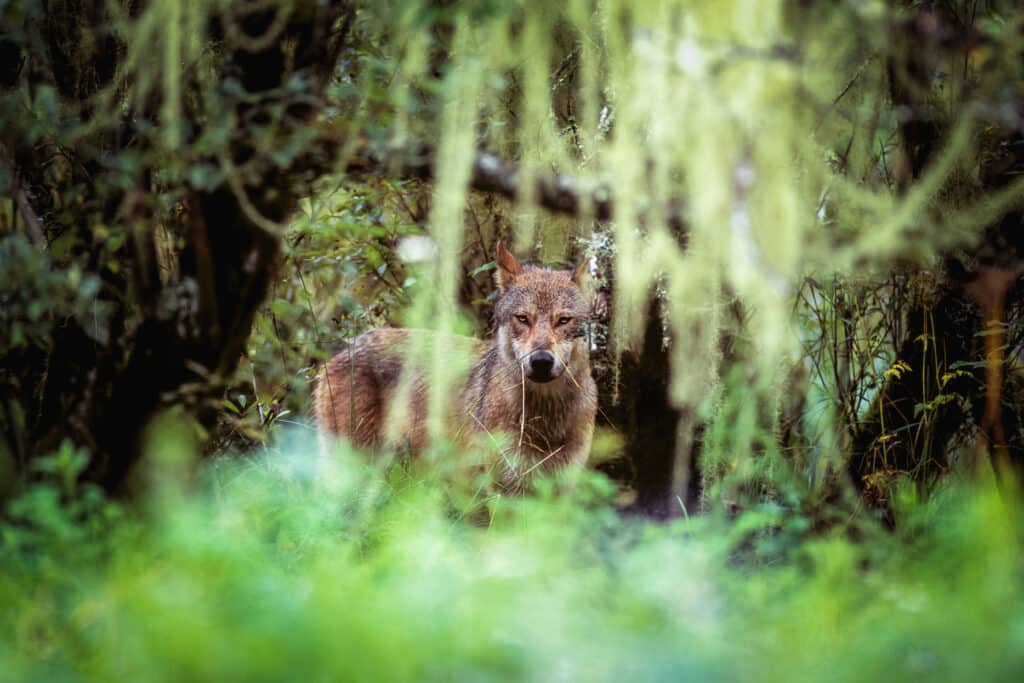Wolves, iconic and vital apex predators, play a crucial role in maintaining healthy ecosystems by regulating prey populations and promoting biodiversity. However hundreds of wolves are being legally killed each year in British Columbia (B.C.), with very little research being done on how this is affecting the ecosystem or wolf populations themselves. The provincial government spends over 1 million dollars each year on a wolf cull program, where hundreds of wolves are shot from helicopters each winter as a part of the government’s Caribou Recovery Program. At the same time, wolves are also being hunted and trapped privately with little regulatory oversight in place. Hunter surveys suggest that the provincial population estimate of wolves could be wildly overestimated due to poor monitoring throughout the province.
Individuals engaging in hunting and trapping for recreational purposes throughout B.C. are required to abide by the B.C. Hunting and Trapping Regulations Synopsis 2022-2024. The document separates the province into nine regions, each subject to its own rules and regulations specific to species, bag limits (the maximum number of animals permitted by law to be taken by one person in a given period), areas of authorization for hunting and prohibited zones.

Recreational Hunting and Trapping of Wolves in B.C.
Most predators subject to hunting in the province, such as cougars and bears, typically require the purchase of a specific species licence or tag; however, no licence or tag is required to hunt wolves. The existing hunting and trapping regulations only mandate compulsory reporting for wolves harvested in Region 1 (Vancouver Island) and Region 2 (Lower Mainland). Reporting is largely self-directed by hunters and done on good faith. The majority of the nine hunting regions in B.C. have no bag limit for wolves, nor do they require data collection by hunters and trappers as a condition of licence. Estimates for the number of wolves hunted are acquired through random selection surveys. These lax regulations and reporting requirements for the hunting of a keystone species in our province are extremely concerning and unacceptable.
“The Hunting and Trapping Synopsis for 2022-2024” states that compulsory inspection (CI) and reporting are a mandate for specific game species under the wildlife act hunting regulations. The CI process may require hunters and trappers to take measurements and submit biological samples of hunted animals for analysis. In correlation with other data collection methods, CI enables wildlife managers to set specific hunting regulations. Without adequate information, the synopsis states there is risk of over-hunting, which reactively requires managers to set more conservative hunting allowances to protect wildlife populations. The province needs to at a bare minimum enforce a bag limit and compulsory reporting for all regions.
The provincial government is already heavily invested in the eradication of wolves in an effort to protect declining caribou populations via culling programs. Though Pacific Wild vehemently stands in opposition to the wolf cull, it stands to reason that data collection and reporting requirements for hunters would be an asset to the province’s ongoing predator management program.

Over the past nine years the provincial government has killed 2,192 wolves at the taxpayers’ expense of ten million dollars. This predator reduction program is rationalised by the Ministry of Water, Land and Resource Stewardship as a short-term and essential measure to preserve and recover endangered caribou. According to the B.C government’s Hunter Sample Survey Estimates*, between 2015-2022 hunters and trappers killed an estimated 5,892 wolves in regions where the wolf cull is also taking place.
The provincial government believes that the median population estimate of wolves in the province stands at roughly 8,500. This estimate, provided in the provincial Grey Wolf Management Plan (2014), is based on two independent wolf estimates that were assessed to create a combined estimate of 5,300 to 11,600 wolves throughout British Columbia. Population estimates are just that – estimates, based on a mathematical model. Renowned wolf biologists John and Mary Therberge explain:
“Any number they give of caribou, wolves, etc must be an estimate, not a full count, the latter being impossible when dealing with large areas. To get an estimate you take a random sample of a certain number of plots all the same size and fly [over] them and count animals, then magnify by the full size of the study area. You get an average from these plot counts, but it is important – really mandatory – to consider the spread of the numbers that went into the average, because the greater the spread, the less confidence you can have in the average.”
The Therberges note that it is nearly impossible to accurately estimate the population because the data over the years fluctuates too much.
Between hunting and predator reduction efforts, at least 8,084 wolves have been killed in the last nine years in British Columbia.

Limited Entry Hunt on B.C. Caribou
There are two types of hunting seasons available to licensed hunters in British Columbia; General Open Season (GOS) which is open to all licensed hunters and is managed by the time duration of permitted hunting, species restrictions and bag limits. The alternative hunting season is Limited Entry Hunt, which is run on a lottery type system, drawing names within applicant pools for specific species within designated areas. In spite of the shocking number of wolves killed in B.C. by the province to ostensibly help caribou populations rebound, Pacific Wild’s research shows that the government is still issuing as many as 255 Limited Entry Hunt (LEH) tags to hunt caribou in two regions of the province where caribou recovery measures and the wolf cull are also taking place.
Although the government may argue that some herds in this region are not endangered, 244 of those tags are tentatively authorised within a management unit (MU) that overlaps the Spatsizi herd, a population of caribou that has not had an estimate completed since 1996. Interestingly, according to the Caribou Recovery Programs Grey Wolf Management Plan, the same region issuing 244 LEH tags for caribou is within Spatsizi Plateau Wilderness Park and was noted to contain the highest concentration of wolves in the province.
According to Canada’s Species At Risk Act, all boreal caribou in B.C. are threatened. Given there are so many endangered herds, with some on the brink of extinction, B.C. should be operating under the precautionary principle. The province should not be allowing the issuance of tags for caribou at all outside of food, social and ceremonial hunting by First Nations. Since the wolf cull began in 2015, as many as 851 caribou have been legally killed by hunters in possession of LEH tags throughout multiple regions. This number, of course, does not account for caribou killed by poachers.

Wolves in the extinction vortex
The government’s predator reduction program not only employs controversial methods, such as aerial shooting, to control predator populations under the guise of preserving endangered caribou but also is a big contributor to potentially exacerbating the decline of wolf populations in B.C.. This program is not only inhumane and unethical but it disrupts delicate ecological balances. B.C. is allowing the widespread killing of wolves with an incredible lack of oversight and monitoring. Without this, the potential of overexploitation and loss of genetic diversity across the province is inevitable.
While the provincial government acknowledges that habitat loss is the main cause of decline of caribou populations in B.C., it also fails to adequately address habitat protection, and instead continues to scapegoat predators, bringing the viability of their populations into question.
Concerning the wolf cull, Dr. John and Mary Theberge conclude that:
“With an objective of leaving the density of wolves below 3 per 1000 km 2 , it is more like population annihilation. Normal density in northern B.C. would be somewhere around 20 wolves per 1000 km 2 , so the killing of this highly social, family-based species is aimed at about 80%. The residual population would have a high likelihood of falling into what wildlife biologists describe as the “extinction vortex,” where the risk of extinction increases as the size of the population decreases. Any recovery then depends upon immigration from surrounding areas, and its probability is a function of outside density and distance. Wolves don’t have in their biological arsenal so-called “compensatory reproduction” that may offset killing, like coyotes do. Excessive wolf killing can result in population genocide and was amply demonstrated by wolf extinction across most of the continental United States in the early to mid 1900s, only reversed recently with reintroduction programs”.

Systemic failures in wildlife management and stewardship
British Columbia’s current wildlife management policies are failing wolves, caribou and the ecosystems they inhabit. Pacific Wild is calling on the provincial government to take urgent action to address these critical concerns before we end up in the same predicament as our US neighbours to the south. The states who have experienced the devastating effects of losing wolves from their landscapes are now implementing reintroduction of the species at taxpayer expense for the overall health and benefit of those ecosystems.
We urge policymakers to prioritise the health of ecosystems over recreational hunting by implementing compulsory inspection and/or reporting requirements for wolf hunting and trapping province wide. Pacific Wild continues to call for an end of the provincial wolf cull and the establishment of protected areas for wolves and other apex predators. Furthermore, we want to see our provincial government hierarchize non-lethal methods of caribou recovery that focus on habitat preservation and legislation to protect not only caribou, but all species at risk.
Under the current mandates for lawful hunting and trapping of wolves the government reveals an outdated and biassed decision-making process that views wolves as disposable. Without immediate implementation of better monitoring efforts pertaining to hunting and a shift towards more science-based and ethical approaches to protect critical caribou habitat, we risk losing both caribou and wolves from our landscapes entirely, which will result in devastating consequences for biodiversity and ecosystem stability. The fate of both of these species in British Columbia hangs in the balance and it is imperative that we act swiftly and decisively to protect these iconic animals.
we need your voice
Send a letter today to demand an end to B.C.’s wolf cull program.

